In Python, working with JSON data is a common task, especially in web development and data exchange scenarios. However, when dealing with numerical data processing or scientific computations, you’re likely to encounter NumPy’s ndarray objects. These powerful array objects enable efficient storage and manipulation of numerical data but pose a challenge when you try to serialize them into JSON format using Python’s standard json module. This leads to the TypeError: Object of type ndarray is not JSON serializable error. This article explores the root cause of this issue and outlines several strategies for effectively resolving it.
Understanding the Error
The TypeError: Object of type ndarray is not JSON serializable error occurs because the json module can only serialize objects of primitive data types (e.g., dict, list, str, int, and float) directly to JSON format. Since ndarray objects do not fall into these categories, attempting to serialize them raises an error. This is particularly common in data science and machine learning projects, where NumPy arrays are used extensively for numerical computations.
Solutions for Serializing ndarray to JSON
1. Convert ndarray to List
The simplest solution is to convert the ndarray object to a list using the .tolist() method. Lists are serializable by the json module, which makes this approach straightforward for arrays of any dimension.
import json
import numpy as np
# Create a NumPy array
array = np.array([[1, 2, 3], [4, 5, 6]])
# Convert the array to a list
array_list = array.tolist()
# Serialize the list to JSON
json_data = json.dumps(array_list)
print(json_data)This method works well for small to medium-sized arrays but might not be the most efficient for very large arrays due to the additional memory required for the list representation.
2. Custom JSON Encoder
For a more elegant and reusable solution, you can create a custom JSON encoder by subclassing json.JSONEncoder. This allows you to define how ndarray objects should be serialized, along with any other non-standard objects you wish to serialize.
import json
import numpy as np
from json import JSONEncoder
class NumpyArrayEncoder(JSONEncoder):
def default(self, obj):
if isinstance(obj, np.ndarray):
return obj.tolist() # Convert ndarray to list
return JSONEncoder.default(self, obj)
# Create a NumPy array
array = np.array([1, 2, 3])
# Serialize the array to JSON using the custom encoder
json_data = json.dumps(array, cls=NumpyArrayEncoder)
print(json_data)3. Using numpy.ndarray.dumps Method
NumPy arrays have a .dumps() method that serializes the array to a string format. However, this format is specific to NumPy and not compatible with JSON. You could use it to serialize the array and then store the serialized string in JSON, but you’ll need NumPy to deserialize it back to an array later.
import json
import numpy as np
# Create a NumPy array
array = np.array([1, 2, 3])
# Serialize the array to a NumPy-specific format
serialized_array = array.dumps()
# Serialize the string representation to JSON
json_data = json.dumps({'array': serialized_array})
print(json_data)
# Note: Deserializing requires NumPy4. Save as JSON-Compatible Format Directly
If the data contained within the ndarray allows for it (e.g., no high-dimensional data or complex numbers), you can directly save it in a JSON-compatible format, like a list of lists for 2D arrays. This approach requires manual conversion and might only be suitable for specific use cases.
Best Practices and Considerations
- Data Size: Large datasets might suffer from performance issues when converted to lists. Assess the trade-offs between ease of serialization and performance.
- Data Loss: Ensure that converting
ndarrayobjects to lists or using the.dumps()method doesn’t lead to a loss of precision or important metadata. - Compatibility: When storing NumPy arrays as strings or in custom formats, ensure that the systems or applications consuming the JSON data can correctly interpret or convert the data back to its original format.
Conclusion
The TypeError: Object of type ndarray is not JSON serializable error in Python arises from attempting to serialize NumPy’s ndarray objects using the standard json module. By converting ndarray objects to lists, implementing a custom JSON encoder, or utilizing NumPy’s serialization methods, developers can overcome this challenge. Choosing the right approach depends on the specific requirements of your project, such as the need for efficiency, the size of the data, and compatibility with other systems.
- How to Add Captions inside Feature Images with GeneratePress - May 8, 2024
- Car Dealership Tycoon Codes: Free Cash for March 2024 - April 9, 2024
- World Solver - April 9, 2024

